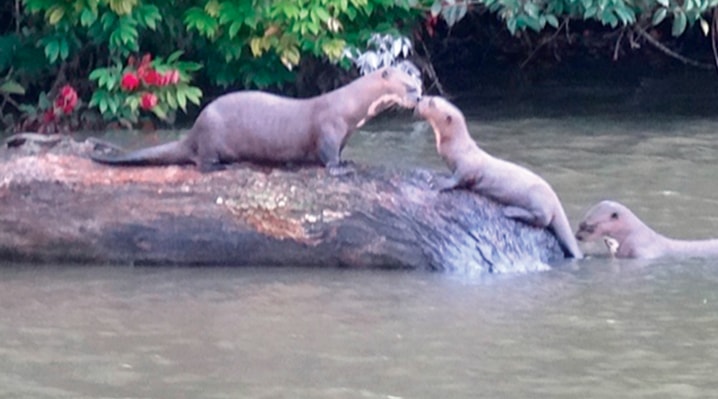Sometimes you have to reframe information before you take action.
With almost three million insect species, you might not believe the Amazon rainforest — sometimes called Amazonia — is a major tourism attraction. I got more excited about visiting when I reframed mosquitoes as not just annoying travel companions, but as important pollinators or bird food. With over 20 per cent of the world’s bird species, there is a real need for insects in Amazonia!
The chance to see colourful parrots, macaws or hummingbirds was one reason I ventured into the Amazon.
The big lure, though, was the chance to see one of the world’s rarest creatures — the giant river otter. At over two metres long, it is the longest member of the weasel family, but extremely shy.
They live in only three Amazonia rivers systems so seeing one requires luck and a location where the otters are known to frequent.
Sandoval Lake Lodge in southeast Peru near the Bolivian border fits the bill, but getting there takes effort. I flew to the frontier town of Puerto Maldonado — a place General Motors forgot. The streets are clogged with motorcycles and jitneys imported from India, and jungle tourism is big business.
From Puerto Maldonado, I boarded a motorized canoe for a 30-minute cruise down the Madre de Dios River.
“Please put your life-jackets on,” our guide directed as we pulled away from shore. “The law requires it, but if we capsize you will be eaten by piranhas or caimans, so really the life-jackets are just for your remains!”
I appreciated his humour or his honesty — his deadpan delivery left me wondering if he was kidding — and was relieved when we arrived at the entrance to Tambopata National Reserve and the start of a three-km hike.
A buff-looking porter pushed a rickshaw laden with our small duffle bags down the muddy, rutted trail while our group picked its way through the rainforest, swatting bugs and enjoying the bird song.
When we reached Sandoval Lake, we boarded a dugout canoe for the final leg.
The porter who pushed our luggage over the bumpy path paddled us across the lake, making my fitness routine look lame in comparison.
Sandoval Lake Lodge offers basic accommodation with electricity a few hours of day, mosquito nets over the beds, and a common longhouse-style ceiling providing only visual barriers between rooms.
I felt I was in an episode of The Waltons each evening as I overheard fellow travellers bid each other goodnight and begin to snore. By morning, I was ready to explore outdoors.
The pre-dawn tour with guide Javier Huayaban turned up a screech owl and an opossum slinking home from his night adventures.
As dawn broke, it was time to search out a wood lick — trees with the minerals that parrots and macaws need for digestion.
We slinked through the forest, careful not to scare off our quarry, and then ruined the effect as our cameras sounded like machine guns, shooting thousands of pictures as we tried to capture the effect of these birds, their feathers as bright as flying crayon-boxes.
We no longer noticed the clouds of mosquitoes.
Knowing I was looking for otters, Javier mentioned that a porter had spotted them near the lodge. As the afternoon sun faded, we headed out in the catamaran — powered by the world’s fittest porters — and got lucky. We found the otter family frolicking near their den, helping the youngest member climb logs and sharing a fish.
Much of their diet is piranha so adults must teach the youngsters how to fish without getting bitten. Otters also show their young how to avoid the black caiman, the largest predator in the Amazon.
I had seen the caimans lurking near the lodge jetty, but on this day they were elsewhere and the otters were free to frolic and display the agility that earned them the nickname ‘river wolf.’
I was still scratching mosquito bites, but I no longer cared.
To see video of the otter encounter, go to http://bit.ly/1e0ghe3
If you go
Sandoval Lake Lodge is the only lodge within Tambopata National Reserve. This provides early morning, evening and night access to the lake and surrounding forests — the best time to see otters, birds and giant anteaters. http://www.inkanatura.com/sandovallakelodge/
Carol Patterson helps businesses and people reinvent themselves through adventure. When she isn’t travelling for work, Carol is travelling for fun. More of her adventures can be found at www.carolpatterson.ca.
